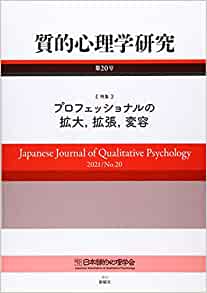Volume 20, Issue 1
Displaying 1-18 of 18 articles from this issue
- |<
- <
- 1
- >
- >|
-
2021 Volume 20 Issue 1 Pages 7-31
Published: 2021
Released on J-STAGE: April 12, 2021
Download PDF (1841K) -
2021 Volume 20 Issue 1 Pages 32-48
Published: 2021
Released on J-STAGE: April 12, 2021
Download PDF (1825K) -
2021 Volume 20 Issue 1 Pages 51-62
Published: 2021
Released on J-STAGE: April 12, 2021
Download PDF (1602K) -
2021 Volume 20 Issue 1 Pages 63-81
Published: 2021
Released on J-STAGE: April 12, 2021
Download PDF (1452K) -
2021 Volume 20 Issue 1 Pages 82-99
Published: 2021
Released on J-STAGE: April 12, 2021
Download PDF (2018K) -
2021 Volume 20 Issue 1 Pages 100-113
Published: 2021
Released on J-STAGE: April 12, 2021
Download PDF (1890K) -
2021 Volume 20 Issue 1 Pages 114-132
Published: 2021
Released on J-STAGE: April 12, 2021
Download PDF (1929K) -
2021 Volume 20 Issue 1 Pages 133-148
Published: 2021
Released on J-STAGE: April 12, 2021
Download PDF (1866K) -
2021 Volume 20 Issue 1 Pages 149-167
Published: 2021
Released on J-STAGE: April 12, 2021
Download PDF (2114K) -
2021 Volume 20 Issue 1 Pages 168-186
Published: 2021
Released on J-STAGE: April 12, 2021
Download PDF (1832K) -
2021 Volume 20 Issue 1 Pages 187-206
Published: 2021
Released on J-STAGE: April 12, 2021
Download PDF (2113K) -
2021 Volume 20 Issue 1 Pages 207-223
Published: 2021
Released on J-STAGE: April 12, 2021
Download PDF (2203K) -
2021 Volume 20 Issue 1 Pages 224-236
Published: 2021
Released on J-STAGE: April 12, 2021
Download PDF (1771K) -
2021 Volume 20 Issue 1 Pages 237-255
Published: 2021
Released on J-STAGE: April 12, 2021
Download PDF (1866K) -
2021 Volume 20 Issue 1 Pages 256-277
Published: 2021
Released on J-STAGE: April 12, 2021
Download PDF (1905K) -
2021 Volume 20 Issue 1 Pages 278-297
Published: 2021
Released on J-STAGE: April 12, 2021
Download PDF (1825K) -
2021 Volume 20 Issue 1 Pages 298-314
Published: 2021
Released on J-STAGE: April 12, 2021
Download PDF (2379K) -
2021 Volume 20 Issue 1 Pages 315-333
Published: 2021
Released on J-STAGE: April 12, 2021
Download PDF (1892K)
- |<
- <
- 1
- >
- >|
